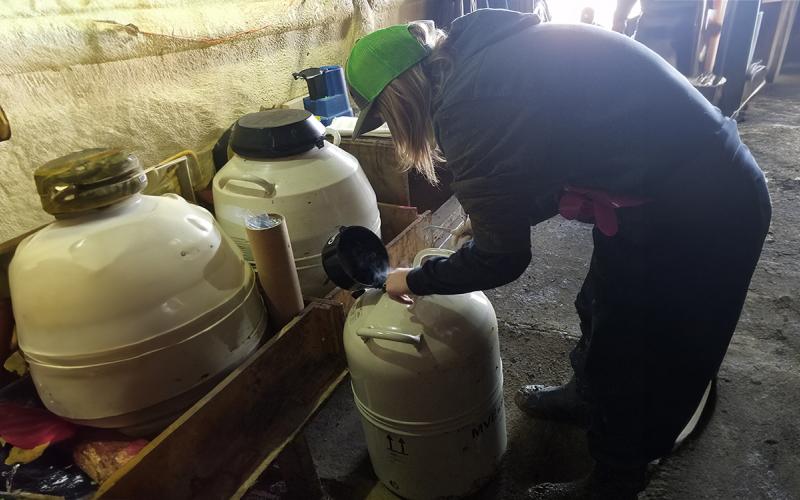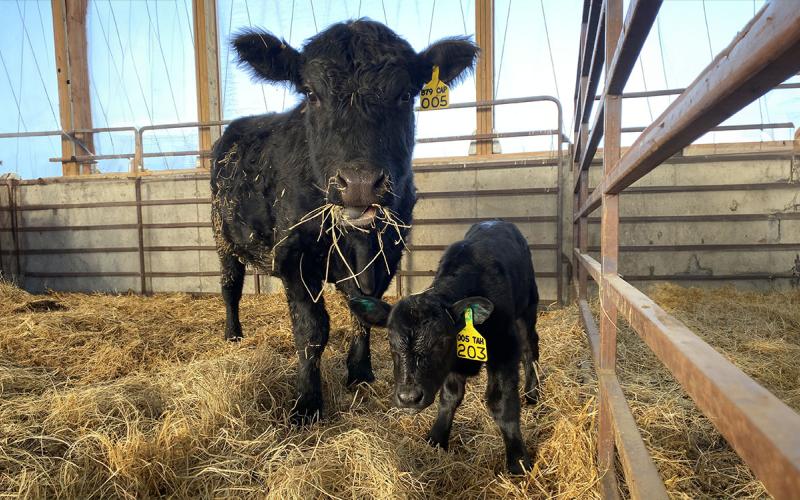
Originally written by Adele Harty, former SDSU Extension Cow/Calf Field Specialist.
As cattle producers begin thinking about calving season and management practices to ease the work load a bit, night feeding is something to be considered. Producers have questioned whether or not time of feeding affects time of calving, and the answer is “Yes.”
What Research Shows
Research indicates that feeding cows later in the day and evening will increase the number of calves born during daylight hours, when it is typically easier to keep a close eye on them. Gus Konefal, a rancher in Manitoba first developed this feeding method after he discovered that 80% of his cows calved between 7 a.m. and 7 p.m when they were fed later in the day. Konefal’s method included a twice a day feeding, with first feeding between 11:00 a.m. and noon and second feeding between 9:30-10:00 p.m.
Similar research at Iowa State University using the Konefal feeding system, but only feeding one time per day at 4 p.m., starting 2 weeks prior to the expected start of calving, resulted in 82% of cows calving between 6 a.m. and 10 p.m. In addition, calves born between 5 a.m. and 11 p.m. (75% of the 24 hour day) was 91%. Therefore, only 9% of calves were born outside the window when traditional calf checks are performed. An important thing to note is that when heifers were separated from the data set and analyzed, 90% of the heifers also calved in this same time frame. A survey collected from 15 beef producers in Iowa and Missouri reported feeding once daily between 5 p.m. and 10 p.m. resulted in 85% of cows calving between 5 a.m. and midnight. Compare this data to cows not on the Konefel feeding system in the same herds that were calving 50/50% day and night.
Researchers at USDA-ARS at Miles City, MT completed at three-year study evaluating differences in feeding time on calving time, but the numbers were not as dramatic as Konefel and Iowa State data. However, there was a consistent 10-20% decrease in the number of cows calving between 10 p.m. to 6 a.m. in the late fed cows compared to the early fed cows.
Things to Consider
Here are some points to remember if Konefal calving will be implemented:
- Research has indicated that for this method to be most effective, it should be started one month prior to calving, but shorter duration before the start of calving will still have some effect.
- Iowa State advises staying as close to the same feeding schedule and feed amount as possible each day. Deviating more than 15 minutes or providing too much feed will yield less desirable results.
- Maintain regular night checks. Konefal calving may simply mean that there will be less work to be done between checks due to fewer calves born during the night.
- It works best in a drylot situation where all feed is provided. Desired effect in a grazing situation may not be seen unless supplemental hay or timing of grazing can be regulated.
- Weather can play a role in effectiveness. Before or during storms, cattle may not come to the bunk to eat and may be more likely to calve at night.
- Additional research indicates that a first calf heifer that calves during the day will tend to calve during the day the remainder of her productive years.
This method of management may help to decrease the number of nights spent up waiting for cows and heifers to calve by helping to move more of the calving to daylight hours.
Sources:
- Brackelsberg, P. O. and D. R. Strohbehn. 1981. Daytime Calving in the Iowa State University Resident Instruction herd and the Rhodes Beef Research Ranch. A. S. Leaflet R332. Iowa State University, Ames, IA.
- Iverson, C. I. 1981. Summary of Survey on “Konefal Method” of Daytime Calving of Beef Cows – 1980. Tenth Annual Cornbelt Cow-Calf conference, Ottumwa, IA.
- Konefal, G. 1980. Daytime Calving – the Konefal Method. Ninth Annual Cornbelt Cow-Calf Conference, Ottumwa, IA.


